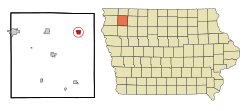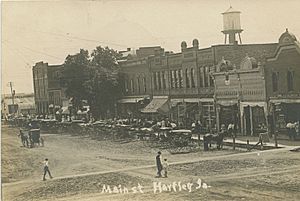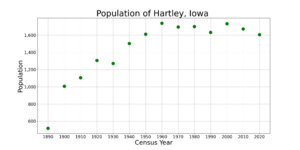Hartley, Iowa facts for kids
Quick facts for kids
Hartley, Iowa
|
|
|---|---|
| Motto(s):
The City with a Heart
|
|

Location of Hartley, Iowa
|
|
| Country | |
| State | |
| County | O'Brien |
| Government | |
| • Type | Mayor-council |
| Area | |
| • Total | 1.33 sq mi (3.44 km2) |
| • Land | 1.33 sq mi (3.44 km2) |
| • Water | 0.00 sq mi (0.00 km2) |
| Elevation | 1,463 ft (446 m) |
| Population
(2020)
|
|
| • Total | 1,605 |
| • Density | 1,206.77/sq mi (465.90/km2) |
| Time zone | UTC−6 (Central (CST)) |
| • Summer (DST) | UTC−5 (CDT) |
| ZIP Code |
51346
|
| Area code(s) | 712 |
| FIPS code | 19-34725 |
| GNIS feature ID | 0457297 |
Hartley is a small city located in O'Brien County, Iowa, in the United States. In 2020, about 1,605 people lived there. Its motto is "The City with a Heart."
Contents
History
Hartley started around 1880. This was after the Chicago, Milwaukee & St. Paul Railway built its tracks through the area. The city was named after John Hartley, who was an official for the railroad.
Geography
Hartley is located in Iowa. The city covers an area of about 1.30 square miles (3.44 square kilometers). All of this area is land, with no large bodies of water.
Major Roads
People of Hartley
| Historical population | |||
|---|---|---|---|
| Census | Pop. | %± | |
| 1890 | 519 | — | |
| 1900 | 1,006 | 93.8% | |
| 1910 | 1,106 | 9.9% | |
| 1920 | 1,306 | 18.1% | |
| 1930 | 1,272 | −2.6% | |
| 1940 | 1,503 | 18.2% | |
| 1950 | 1,611 | 7.2% | |
| 1960 | 1,738 | 7.9% | |
| 1970 | 1,694 | −2.5% | |
| 1980 | 1,700 | 0.4% | |
| 1990 | 1,632 | −4.0% | |
| 2000 | 1,733 | 6.2% | |
| 2010 | 1,672 | −3.5% | |
| 2020 | 1,605 | −4.0% | |
| U.S. Decennial Census | |||
2020 Population Count
In 2020, Hartley had 1,605 people living in 679 households. About 25% of these households had children under 18. The average age of people in Hartley was 44.4 years old.
Most of the people in Hartley (89%) were White. About 8.5% of the population identified as Hispanic or Latino.
2010 Population Count
In 2010, there were 1,672 people living in Hartley. The average age was 44.3 years. About 26% of the people were under 20 years old.
Fun Things to Do
Yearly Events
Hartley celebrates an event called Summerfest every year. It takes place during the first weekend of August.
Parks and Sports
Hartley has two local parks: Neebel and Shinkle. Neebel Park has a new public swimming pool.
If you like golf, there's the Meadowbrook Golf & Country Club. It's a 9-hole golf course located just south of Hartley. It was even named Iowa's 9-Hole Course of the Year in 2003.
Education
Hartley is part of the Hartley–Melvin–Sanborn Community School District. This school district was formed in 1991.
The city is home to both the Hartley–Melvin–Sanborn Elementary School and the Hartley–Melvin–Sanborn High School.
Religion
Covey Church was built in 1874. It is the oldest church building in all of O'Brien County.
Olhausen Pool Hall
Hartley was once home to the Olhausen Pool Hall. This pool hall was where the famous Olhausen Billiard Company of San Diego first started.
Famous People
Several notable people have connections to Hartley:
- Everett Dunn (1892–1980), a civil engineer and negotiator.
- Jim Fanning (1927–2015), a professional baseball player, manager, and general manager.
- Wesley Leonard "Cowboy" Fry (1902–1970), a football player and coach.
- Bonnie Linder (1927–2020), known for a popular online video.
- Vicki Myron (born 1947), an author who wrote the book Dewey: The Small-Town Library Cat Who Touched the World.
- Maurice Pate (1894–1965), one of the people who helped start United Nations Children's Fund (UNICEF) in 1947.
See also
 In Spanish: Hartley (Iowa) para niños
In Spanish: Hartley (Iowa) para niños



